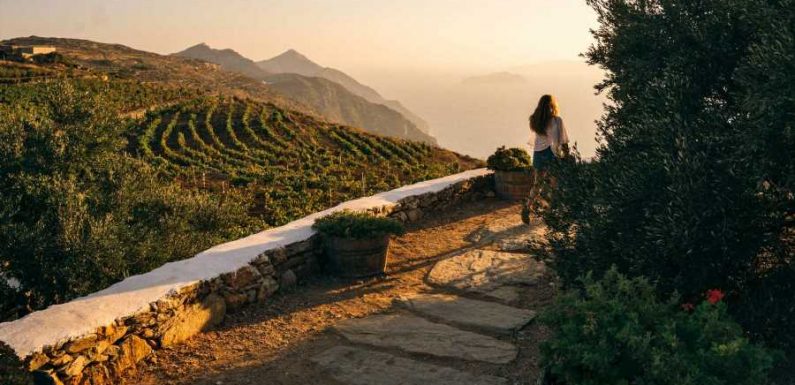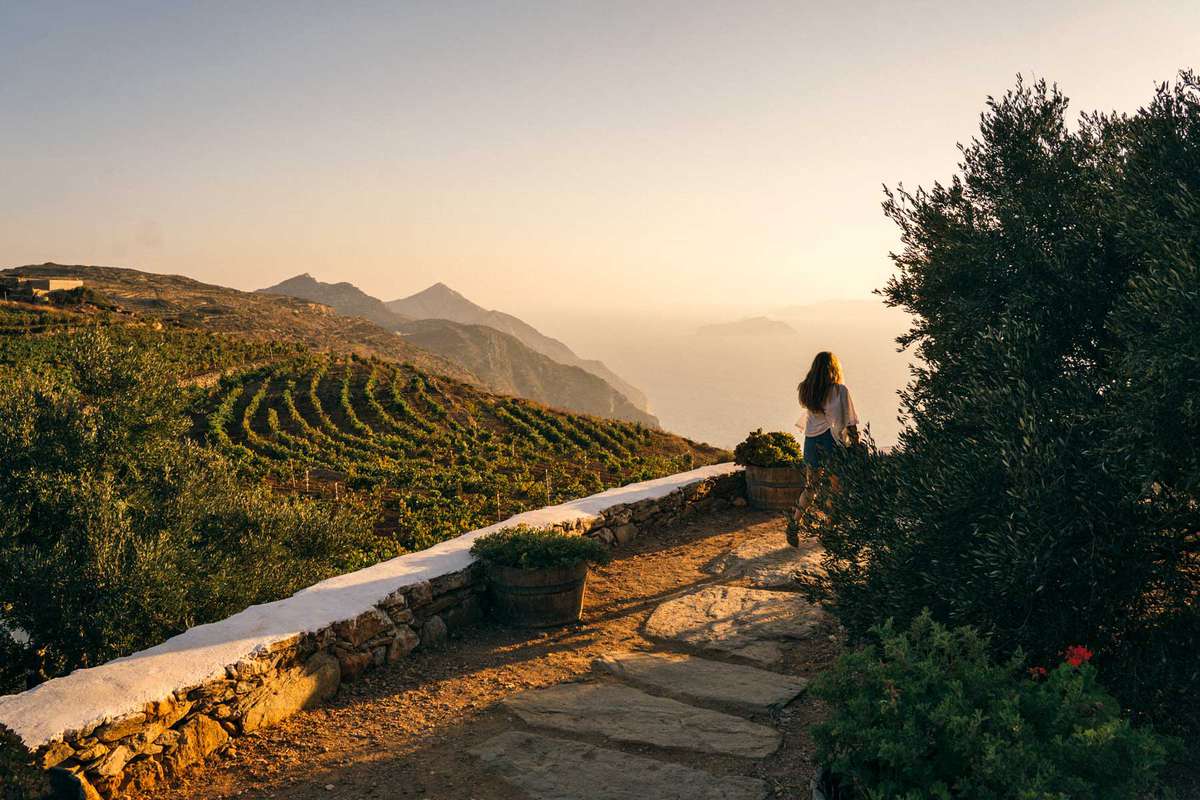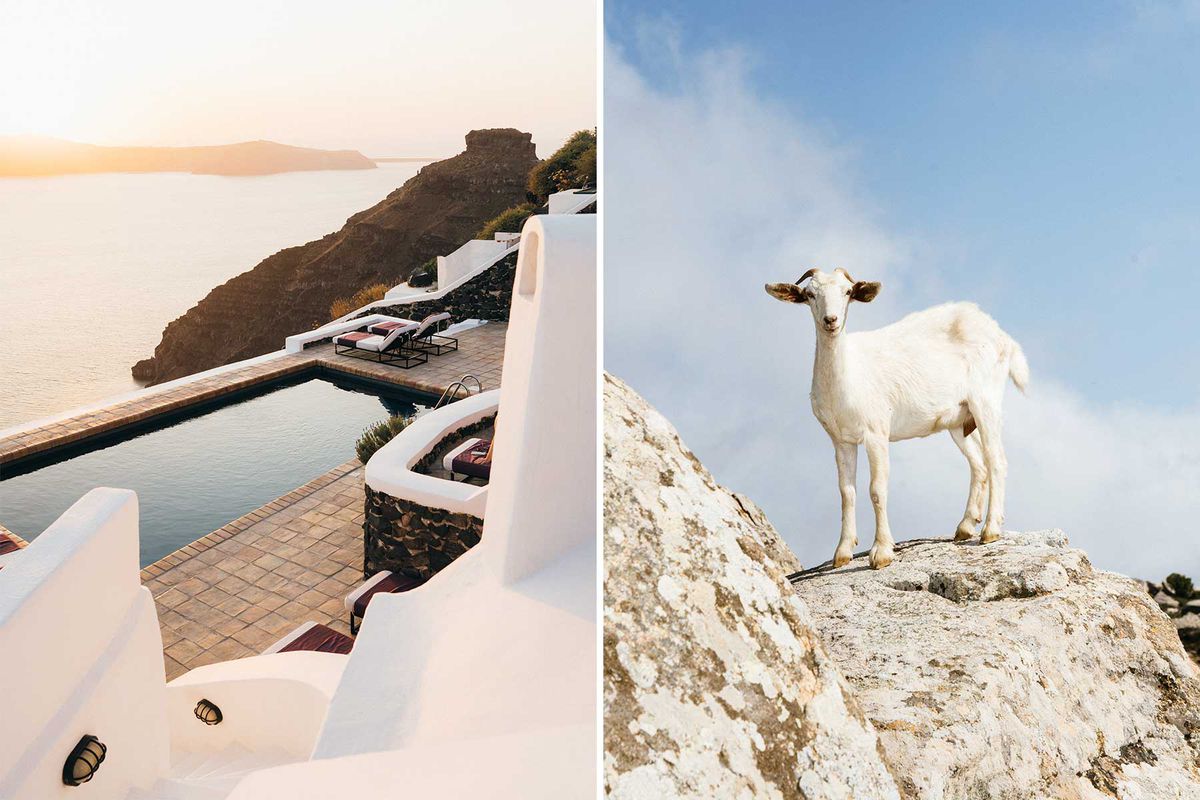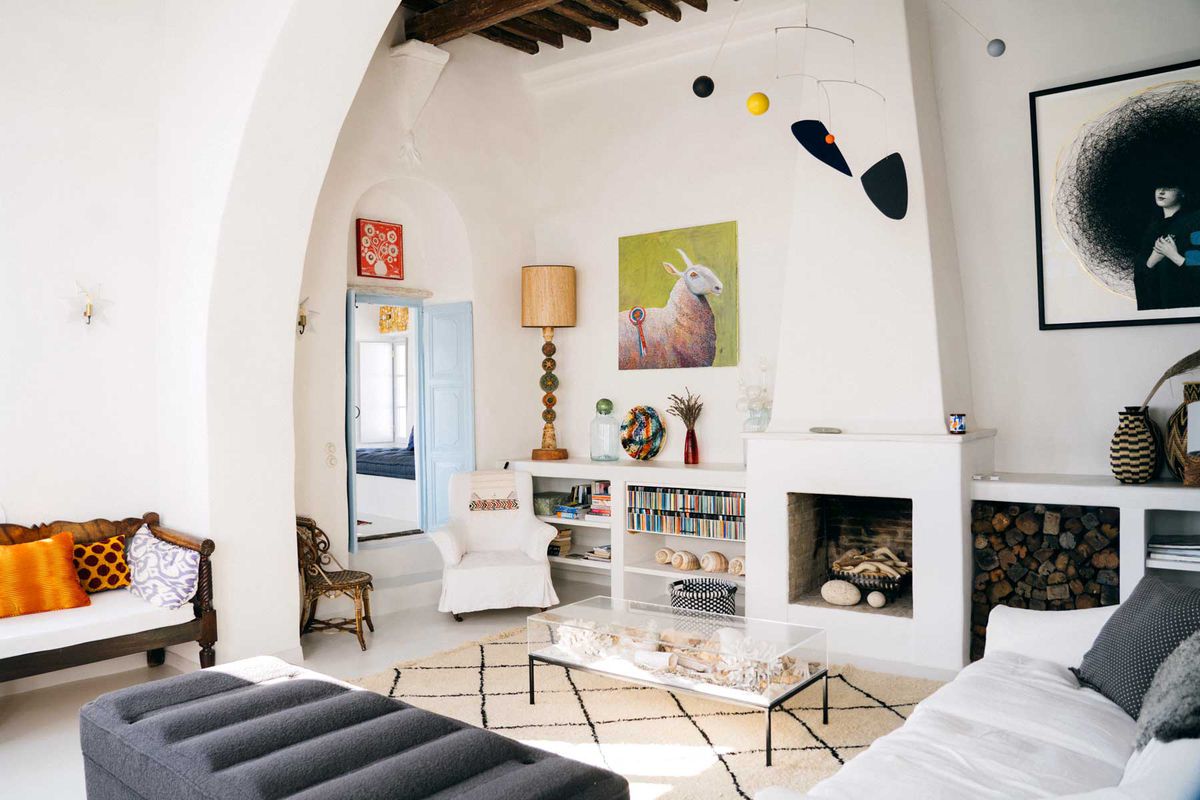
Editor's Note: Those who choose to travel are strongly encouraged to check local government restrictions, rules, and safety measures related to COVID-19 and take personal comfort levels and health conditions into consideration before departure.
Jenny Prinea, the manager of my rental villa on the Greek island of Tínos, pointed to Exomvourgo, the rust-colored rock monolith looming above us. "Last night there was a full moon," she said. "A couple of friends and I climbed to the top to celebrate with a bottle of wine." She added this so naturally that I figured it was a monthly occurrence. I was instantly charmed — and kicking myself for not coordinating my travel with the lunar cycle.
There was no full moon in sight that night, but I could at least drink wine. Much like bread and olive oil, wine is an integral part of the Hellenic diet. The ancient Greeks believed it was invented by Dionysus, the god of revelry. In the Byzantine and Ottoman empires, Greek wine was considered a delicacy. Since the mid 20th century, though, it has been held in relatively low esteem in Europe; EU regulations clamped down on distribution, and most non-Greeks have only ever sampled retsina, a sickly-sweet taverna wine that is reminiscent of Manischewitz. It's an unfortunate reputation, and one that couldn't be further from the truth.
The majority of Greece's top producers are on the mainland; the Cyclades are not particularly well known for viticulture. In fact, there are parts of Tínos that seem like an improbable place to grow anything. The eastern part of the island is full of granite rocks that look like they've been left behind by giants playing a particularly competitive game of dice. Goats clamber over boulders, gray surfaces reflecting the bright sun — the only things that remain impassive in the face of the whipping wind. Yet, Tínos and its neighbors are home to a growing number of winemakers harnessing this terroir to create some of the most interesting wines in Greece.
Natural wine has no established definition. There are related terms: organic refers to the process for growing grapes (no chemical fertilizers, pesticides, or fungicides), while biodynamic describes a method of integrated farming that uses herbal preparations to nourish the soil and vines. In the most basic terms, natural simply indicates as little intervention as possible throughout the harvesting and fermenting process. For some winemakers, it's a philosophy — an almost spiritual devotion to nature in its purest form.
Jérome Charles Binda, who owns a vineyard in the remote hills above Falatados, also on Tínos, falls into this group. A former antiques dealer and graphic designer from Paris, he has produced small quantities of natural, unfiltered wine under his deeply experimental label Domaine de Kalathas since 2015. His semi-wild vineyards grow varieties indigenous to Tínos, like Aspro Potamisi and Mavro Potamisi. He uses no sulfites, allows weeds and herbs to grow around the vines, and fertilizes with sheep manure and compost. The bottle labels read, in French, "Living Wine of Greece."
"It's out of the box, and it has to be," Binda told me when I visited last October, just a few weeks after the small team's grueling harvest. "I know it can't please everyone — but it is honest and sincere."
Domaine de Kalathas has become one of the more culty natural-wine labels in Greece. Binda's careful work yields golden wines that are textural and unusual; the experimental nature of the vineyard means the wine changes dramatically each year. Part of the appeal is that it is difficult to get. Binda does not officially organize tours or tastings. He has no public phone number or website, only an Instagram account that he checks periodically. I enjoy a challenge and found this delightfully adventurous, but non-obsessive types may prefer to taste Binda's wines at a restaurant like the seaside To Thalassaki (entrées $15–$40), in the village of Ysternia Cove, paired with local seafood and vegetables.
After a day at Binda's winery, I headed back to my villa at Xinara House (rentals from $640, three-night minimum), a former bishop's residence in the tiny, heart-achingly beautiful village of Xinara. Restored by a charming British designer-artist couple named Peter and Susan Marston, the property is situated at the foot of Exomvourgo and close to Chora, as the main town on most Greek islands is known, and, more importantly, its wineries. I sampled a bottle of Kalathas by Xinara's rock-cut swimming pool — which overlooks the hill where the Marstons have also planted a few of their own vines, intended for the 2022 house rosé.
A short drive away, in Falatados, is T-Oinos, where businessman Alexander Avatangelos has partnered with Gérard Margeon, head sommelier for Alain Ducasse's worldwide restaurant group, and Stéphane Derenoncourt, a master vigneron from France. T-Oinos adheres to the principles of biodynamic farming and is striving for an international level of wine-making excellence. With the team's pedigree and skill set, it's getting close.
"We try to preserve the energy of the location," chief enologist Thanos Giorgilas told me. All wine tastes better in the place it is made, but I found that particularly true here. Tours include a visit to the estate's vineyards, where the grapevines grow between the boulders. Back in the tasting room, the Assyrtiko was a must-try — the best I've ever had, so bright and mineral it was like drinking liquid pebbles.
Assyrtiko is the best-known variety of Greek grape, and it is indigenous to Santorini, where large-scale wineries often host busloads of tourists. But COVID-19 restrictions meant that, when I visited in the fall, I had the island, and the standout Vassaltis Vineyards, largely to myself. "We are proud to live and work with a terroir like Santorini," enologist Elias Roussakis said. "The vines yield a very special result." Santorini is a volcanic island, and an explosion some 3,700 years ago has resulted in a layer of mineral-rich soil called aspa. Vassaltis's Assyrtiko is mineral and highly acidic, with an oaky finish. Roussakis also makes a fun sparkling wine from a blend of Assyrtiko, Aidani, and Athiri. The winery follows principles of organic farming and minimal intervention. As elsewhere on Santorini, vines are woven into low-lying spirals that create a sort of basket, inside of which the grapes can ripen while remaining shielded from the island's brutal winds.
I learned about Vassaltis through its sister business, the Vasilicos (doubles from $405, three-night minimum), the island's only wine-themed hotel. Daphne Valambous and her brother, Yannis, inherited both properties from their father. She oversees the hotel with a thoughtful eye — the cave rooms, built into the cliffside, are stocked with fresh flowers and Greece-centric literature — while he looks after the wine making. Hotel guests are encouraged to visit the winery, or wander into Fira, where the fine-dining restaurant Selene (tasting menus from $133) has the best wine list on the island. But as so often happens on Santorini, it became very difficult to peel myself away from my terrace and the jaw-dropping caldera view. It is helpful, then, that Vassaltis wine is already chilling in the hotel's mini fridges.
A quick boat ride took me from Santorini to Sikinos, a tiny island with a year-round population of less than 300 people — all of whom know one another, and will come to know you, too, as soon as you step onshore. Sikinos is one of those islands that makes you dream of spending three months nude on a deserted beach. In autumn, there is very little to see — aside from the island's monastery, run by a friendly nun — or do, besides rambling walks along the cliffs. That, and drinking wine, of course.
Giorgos Manalis is the island's only winemaker. The former fisherman gave up the trade several years ago after a boating accident, channeling his love of the sea into the vines on his family's plot of land, located on a cliff that plunges down into the Aegean. The product at Manalis Winery is still evolving — the wines are young but easy to drink — but his property alone is worth the ferry ride. A terrace juts out from the cliffside, suspending you in that hazy place between the Aegean and the Cycladic sky. For my three days on Sikinos, I spent every afternoon on that terrace. Each evening, the sun would set, and I would raise my glass.
A version of this story first appeared in the April 2021 issue of Travel + Leisure under the headline Sun, Sea, and Soil.
Source: Read Full Article














